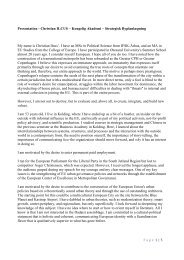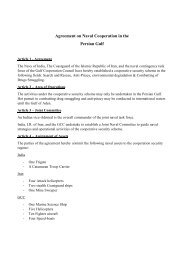china IR rev final sept 2023
This is the fourth and penultimate edition of my annotated bibliography on China international relations, art and Philosophy. from the books I distill policy relevant ideas for use and comsideration of policymakers after the ratification of the Cai, when the relatioship willl have to be managed
This is the fourth and penultimate edition of my annotated bibliography on China international relations, art and Philosophy. from the books I distill policy relevant ideas for use and comsideration of policymakers after the ratification of the Cai, when the relatioship willl have to be managed
Create successful ePaper yourself
Turn your PDF publications into a flip-book with our unique Google optimized e-Paper software.
Fang Cai, Xiaojing Zhang & Guopeng Yu Constructing Political Economy<br />
with Chinese Characteristics, Springer, 2022.<br />
This book analyses the characteristics of China’s economic operation in the new era and explores Xi’s thoughts on<br />
China’s development. The book is divided into six parts. First, the guiding principles and main contents of the political<br />
economy of socialism with Chinese characteristics. Second addresses epistemology and methodology. The third part<br />
<strong>rev</strong>eals the extensive logic of the new normal of economic development from the time and space dimensions. The fourth<br />
part examines the purpose, motivation, necessary conditions, and measurement of the scale of action according to the<br />
new development concept. The fifth part discusses the path of building a modern economic system. Finally, the last part<br />
focuses on how China’s wisdom and China’s solution could contribute to global governance and the promotion of<br />
development. An antidote is provided by Emmanuel Dubois de Prisque & Sophie du Rocher Le Chine et le Monde:<br />
essai sur la sino-mondialisation.<br />
Ho-Fung Hung City on Edge: Hong Kong under Chinese rule, Cambridge,<br />
UP, 2022<br />
Hong Kong has maintained precarious freedom at the edge of competing world powers for decades. In the City on<br />
Edge, Ho Fung Hung offers a timely and engaging account of Hing Kong’s development from pre-colonial times to the<br />
present, focusing on the post-1997 handover period. Through careful analysis of vast economic data, a myriad of<br />
political events, and intricate networks of actors and ideas, Hung offers readers insight into the fraught economic,<br />
political, and social forces that led to the 2019 uprising while situating the protests in the context of global finance and<br />
the geopolitics of US-China rivalry.<br />
Susan L. Shirk Overreach: How China Derailed its Peaceful Rise, OUP,<br />
2022.<br />
As the book’s titles suggest, something has changed in China. It no longer reassures the world that its rise to power will<br />
be peaceful, believing that internal threats to the Communist Party’s control were the leading cause of a restrained<br />
approach to foreign policy. Instead, they reassured the outside world of China’s peaceful intentions to facilitate the<br />
country's inevitable economic ascendance and p<strong>rev</strong>ent a backlash. Then something changed. China went from fragile<br />
super-power to global heavyweight, threatening Taiwan and its Neighbours in the South China Sea, tightening its grip<br />
on Hong Kong, and openly challenging the United States for preeminence economically and technologically militarily.<br />
China began to overreach. To counter it, Shirk argues that the worst mistake the rest of the world, and the United States<br />
in particular, can make is to overreact. Understanding the domestic roots of China’s actions will enable us to avoid the<br />
mistakes that could lead to war.<br />
Jianwei Wang & Weiqing Song The European Union in the Asia-Pacific:<br />
Rethinking Europe’s strategies and policies, Manchester UP, 2022.<br />
It is to Hans Maull, Gerald Segal, and Jusuf Wanandi’s book Europe and the Asia Pacific that we owe the origins of<br />
the three geographical terms: Asia-Europe (Assyrian: Asu-Ereb), the Asia Pacific, encompassing the Americas, Russia,<br />
Australia, New Zealand, and the South Pacific, and Pacific Asia inclusive China, Japan and South Korea and the Asian<br />
countries on the pacific rim. The implicit assumption is that the European Union may contribute to the forging of an<br />
East Asian caucus by exploiting the European’s desire for markets and their bad conscience. The EU, however, doesn’t<br />
have a policy towards the Asia-Pacific. Instead, the European Union has an Asia policy that needs a policy <strong>rev</strong>iew and<br />
an Indo-Pacific strategy hatched in part in exchange for US assistance in Ukraine and the Middle East, where the EU<br />
felt let down by the Obama administration 20 . The authors claim, however, that the EU has defined the Asia-Pacific since<br />
the 1980’ies as one of its strategic targets on its ambitious road toward a global power. Therefore, they contend<br />
correctly that it is high time to evaluate the EU’s performance in its Asian policy. The EU must redefine its interests and<br />
roles and rethink its strategies and policies towards the dynamic and ever-important Asia Pacific region. This book<br />
addresses this theme by elaborating on the general context, significant issues, and countries in the EU’s Asia (Pacific)<br />
20<br />
See Alice Ekman China and the battle for coalitions, Challiot Paper, The circle of friends versus the Indo-Pacific<br />
Strategy. Or better: Felix Heiduk Europe’s Foray into the Indo-Pacific”, European Review of International Studies,2022.<br />
Page 16 | 29








